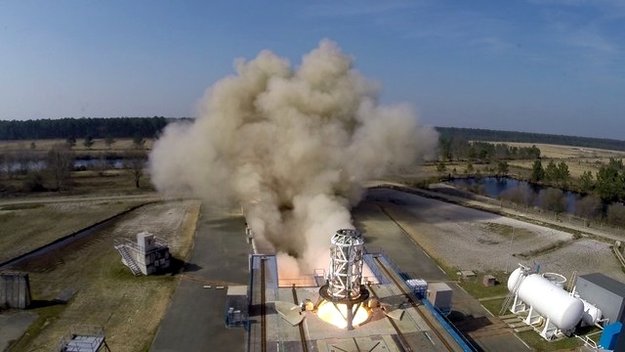.

The Pressure Oscillation Demonstrator – eXperimental (POD-X) is an experimental simulator used to measure pressure oscillations in solid rocket boosters for present and future launchers.
The POD-X incorporates 263 sensors, is 6 m long and 70 cm in diameter and can hold 2700 kg of propellant. Testing can last for 27-30 seconds at a nominal pressure of 65 bars.
.

The first hot fire test of the Pressure Oscillation Demonstrator – eXperimental (POD-X) demonstrator took place at the French military procurement agency test site in southwest France on 11 March 2014.
POD-X is an experimental simulator used to measure pressure oscillations in solid rocket boosters for present and future launchers. It incorporates 263 sensors, is 6 m long and 70 cm in diameter and can hold 2700 kg of propellant. Testing can last for 27-30 seconds at a nominal pressure of 65 bars.
.
The first hot fire test of an experimental simulator to measure pressure oscillations in solid rocket boosters was performed yesterday at the French military procurement agency test site in Saint Jean d’Illiac, France.
Controlling these oscillations is a critical factor in designing rocket motors using solid propellant.
The success of this first test opens the way to producing and studying controlled oscillations to understand the underlying physics. The goal is to devise countermeasures that will drastically reduce the effect in future motors.
The Pressure Oscillation Demonstrator eXperimental (POD-X) is the result of a cooperation between ESA’s Future Launchers Preparatory Programme and France’s CNES space agency.
The simulator was designed and built by prime contractor Europropulsion with partners Herakles and Avio SpA, with France’s DGA military procurement agency responsible for operations and testing.
Thrust oscillations are a small percentage of the overall thrust level but can have major impacts on the design of the motor components, vehicle structure, avionics and payload.
The test today mimicked the firing of Ariane 5’s boosters at a reduced scale of 2:9. It lasted 28 seconds at a pressure of 65 bars. The data will help to validate the numerical modelling tools for mastering the phenomenon.
POD-X incorporates 263 sensors, is 6 m long, 70 cm in diameter and can hold 2700 kg of propellant. Its modular metallic cylinders and domes can be assembled in various ways. The case components are made of high-strength steel, together weigh close to 4 t and are designed to be reused 30 times.
This approach allows multiple configurations and innovative technologies to be tested in a representative way. Some of the concepts envisaged for Ariane 6 will be tested in this simulator.
The Future Launchers Preparatory Programme (FLPP) was set up by ESA in 2003 to anticipate the needs of developing launcher technology, be it for Ariane, Vega or future launch vehicles.
Launcher technology matures by combining different technologies and ultimately testing them using large integrated demonstrators. FLPP is the link between concept and demonstration to accelerate the move to maturity and to mitigate the risks.
Improving propulsion techniques is important for maintaining and widening our gateway to space. It takes extreme speed to reach orbit and precisely controlled thrust to get a mission where it needs to be. Without propulsion technology, nothing goes anywhere.
Quelle: ESA
5254 Views
